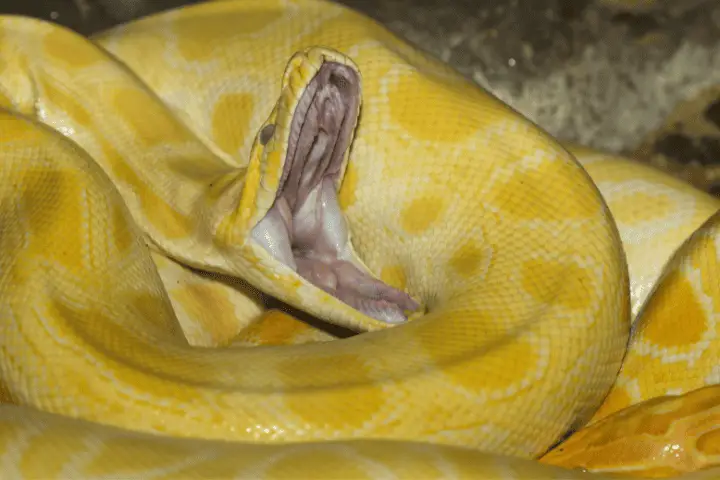Why Do Snakes Yawn
Snakes – mysterious creatures that slither through our dreams and nightmares.
But have you ever pondered why they yawn?
Humans associate yawning with tiredness or boredom, yet snakes have a different reason.
Why Snakes Yawn
Yawning in snakes has a dual purpose.
First, it helps them realign their jaws after a meal. We know snakes can eat prey much larger than themselves.
When they unhinge their jaws, the muscles around them can become strained or misaligned. Yawning allows them to stretch these muscles and get them back in place.
Secondly, yawning enables snakes to regulate their body temperature. Being ectothermic, they depend on heat sources outside of themselves to maintain their body temperature.
By opening their mouths wide and letting in cool air during a yawn, they can reduce their body temperature and avoid overheating.
What caused snake yawning remains an enigma. But, we do have tales from ages past that could give us some insight.
The phenomenon of Snake Yawning
Definition of snake yawning
Snakes open their mouths in a yawn-like gesture, which can be misunderstood as a sign of boredom or fatigue. But there’s more to it than that.
There are several important purposes for yawning.
Firstly, it helps regulate temperature, allowing snakes to cool off.
Secondly, it helps with jaw stretching and muscle relaxation. This means they can consume bigger prey and keep their mouths healthy.
Plus, snake yawning has been seen during times of stress or agitation. Just like humans fidget or become restless when anxious, snakes yawn to calm themselves down.
It shows how complex these creatures are, emotionally.
Interestingly, this behavior has been around for centuries. Ancient cultures saw the yawning snake as a symbol of wisdom and transformation.
It was said that they’d yawn before shedding their skin and becoming renewed. This gives us a greater insight into the act of yawning.
Frequency of snake yawning
How often do snakes yawn? An intriguing aspect of their behavior! Let’s explore it in more detail.
Here’s a table:
| Species | Frequency |
|---|---|
| Cobra | 3x/day |
| Python | Every few days |
| Boa Constrictor | Twice/week |
| Rattlesnake | Every couple of hours |
Interesting to note, when stressed or nervous they tend to yawn more. This highlights the complexity of their behavior.
Observations and theories on snake yawning
Different species of snakes yawn differently. Some stretch their jaws wide open, while others just move their jaws a bit. What’s the purpose of this?
After a period of rest or inactivity, many snakes yawn. Could this be to wake up their bodies and get ready for action, like hunting? Studies have shown that yawning can increase oxygen intake and alertness.
Suggestions for future research:
- Research the behavior of snakes during aggressive encounters to see if there’s any communication involved.
- Measure oxygen levels before and after yawning, and monitor body temperature variations.
- Analyze if there are anatomical differences between species that yawn differently.
Possible reasons for snake yawning
Temperature regulation hypothesis
Snakes yawn for more than just fatigue. The Temperature Regulation Hypothesis suggests it helps regulate their body temp.
Being ectothermic, they rely on outside sources of heat. By opening their mouths wide, they let out excess heat and cool down.
Yawning also helps their respiration. Unlike mammals, snakes don’t have a diaphragm. They rely on the expansion of throat and mouth muscles to draw air into their lungs.
Yawning stretches these muscles for deep inhalation and exhalation. This helps them take in enough oxygen.
Yawning gives multiple benefits – regulating body temperature and respiration. It’s an adaptation that showcases nature’s intricate design.
Stress and anxiety hypothesis
Snake yawning could be a sign of stress and anxiety. It’s believed that snakes yawn as a coping mechanism in stressful situations.
This is supported by several points:
- Predators and captivity can trigger yawning in snakes, suggesting it helps reduce stress and anxiety.
- Studies show snakes yawn more when stressed. This indicates a connection between stress and yawning.
Yawning has a calming effect on snakes. It’s thought that yawning releases tension and lowers their stress levels.
Yawning also coincides with other signs of anxiety or distress, like increased body movements or defensive behavior. This further suggests yawning is an indicator of stress in snakes.
Stretching and muscle relaxation hypothesis
Snakes have their own way of communicating. Yawning can be a sign of submission and dominance. It also helps regulate their body temperature.
Ectothermic animals, they rely on external sources of heat to warm up and cool down.
Yawning is a complex behavior that has multiple purposes. So, if you spot a snake yawning, admire from afar.
Comparative analysis with other animals’ yawning behaviors
Yawning in mammals
Mammals yawn for various reasons, such as fatigue, stress, or social cues. It increases oxygen intake and blood flow to the brain.
Yawning is contagious among humans and other primates. Studies suggest it may even regulate body temperature.
Different species have different patterns of yawning.
Despite research, details remain unknown. Specific triggers can induce more frequent yawning in certain species.
They may also yawn more at certain times and in certain environments.
One case study showed Betty, a chimpanzee, yawning when a zookeeper brought food. This suggests Betty associated yawning with anticipation and excitement, not tiredness.
This reveals the complexity of mammalian yawning and potential for individual variations.
Keep an eye on reptiles – their jaw-dropping yawns might indicate something big! Or just a nap.
Yawning in reptiles other than snakes
Yawning isn’t exclusive to snakes. Reptiles also do it! Let’s take a look at the yawning habits of other reptiles:
- Chameleons: These incredible animals can change colors! They also yawn often. It’s thought chameleons yawn to regulate body temperature.
- Turtles: While turtles look unassuming, they yawn too. It could be a sign of alertness or a method of communication.
- Lizards: Yawning in lizards is like stretching exercises. Like humans, they yawn to relax and prepare their bodies for activity.
- Crocodiles: Even crocodiles yawn. It helps them realign their jaws and prevents damage when they feed.
- Tortoises: Tortoises yawn too. But it may be related to digestion and thermoregulation more than behavior.
Yawning can tell us something about reptilian behavior. Observing their yawning habits can help us understand these ancient creatures better.

